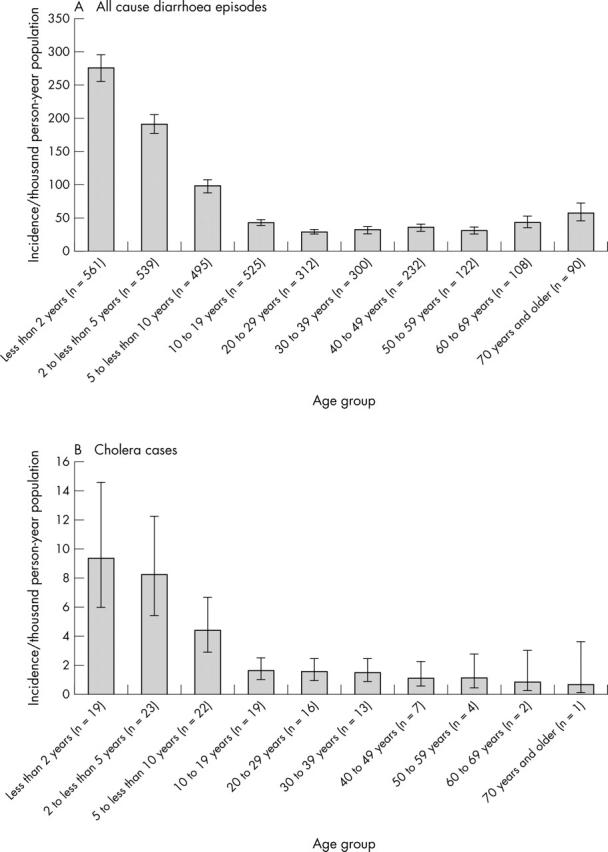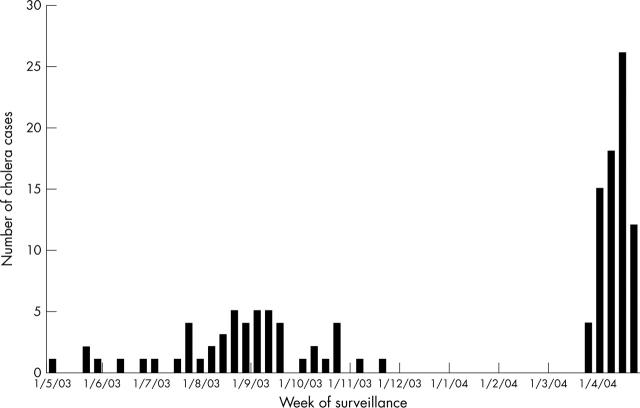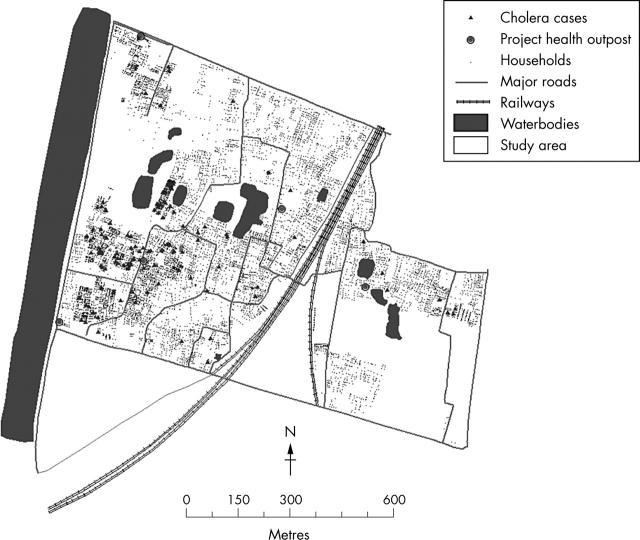Abstract
Aims: To conduct a prospective, community based study in an impoverished urban site in Kolkata (formerly Calcutta) in order to measure the burden of cholera, describe its epidemiology, and search for potential risk factors that could be addressed by public health strategies.
Methods: The study population was enumerated at the beginning and end of the study period. Surveillance through five field outposts and two referral hospitals for acute, watery, non-bloody diarrhoea was conducted from 1 May 2003 to 30 April 2004. Data and a stool sample for culture of Vibrio cholerae were collected from each patient. Treatment was provided in accordance with national guidelines.
Results: From 62 329 individuals under surveillance, 3284 diarrhoea episodes were detected, of which 3276 (99%) had a stool sample collected and 126 (4%) were culture confirmed cholera. Nineteen (15%) were children less than 2 years of age, 29 (23%) had severe dehydration, and 48 (38%) were hospitalised. Risk factors for cholera included a household member with cholera during the period of surveillance, young age, and lower educational level.
Conclusions: There was a substantial burden of cholera in Kolkata with risk factors not easily amenable to intervention. Young children bear the brunt not only of diarrhoeal diseases in general, but of cholera as well. Mass vaccination could be a potentially useful tool to prevent and control seasonal cholera in this community.
Full Text
The Full Text of this article is available as a PDF (209.9 KB).
Figure 1.

Flow of patients visiting a project health outpost in a study site in Kolkata, India, 1 May 2003 to 30 April 2004.
Figure 2.

Age specific incidence rate (per 1000 person-years) of all cause diarrhoea episodes and cholera cases in a study site in Kolkata, India, 1 May 2003 to 30 April 2004.
Figure 3.
Cholera cases by week of surveillance in a study site in Kolkata, India, 1 May 2003 to 30 April 2004.
Figure 4.
Geographic location of households of cholera cases in a study site in Kolkata, India, 1 May 2003 to 30 April 2004.
Selected References
These references are in PubMed. This may not be the complete list of references from this article.
- Ali Mohammad, Rasool Shahid, Park Jin-Kyung, Saeed Shamoon, Ochiai Rion Leon, Nizami Qamaruddin, Acosta Camilo J., Bhutta Zulfiqar. Use of satellite imagery in constructing a household GIS database for health studies in Karachi, Pakistan. Int J Health Geogr. 2004 Sep 28;3(1):20–20. doi: 10.1186/1476-072X-3-20. [DOI] [PMC free article] [PubMed] [Google Scholar]
- Bhattacharya S. K., Datta D., Bhattacharya M. K., Garg S., Ramamurthy T., Manna B., Nair G. B., Nag A., Moitra A. Cholera in young children in an endemic area. Lancet. 1992 Dec 19;340(8834-8835):1549–1549. doi: 10.1016/0140-6736(92)92804-o. [DOI] [PubMed] [Google Scholar]
- Glass R. I., Becker S., Huq M. I., Stoll B. J., Khan M. U., Merson M. H., Lee J. V., Black R. E. Endemic cholera in rural Bangladesh, 1966-1980. Am J Epidemiol. 1982 Dec;116(6):959–970. doi: 10.1093/oxfordjournals.aje.a113498. [DOI] [PubMed] [Google Scholar]
- Newcombe R. G. Interval estimation for the difference between independent proportions: comparison of eleven methods. Stat Med. 1998 Apr 30;17(8):873–890. doi: 10.1002/(sici)1097-0258(19980430)17:8<873::aid-sim779>3.0.co;2-i. [DOI] [PubMed] [Google Scholar]
- Sack R. Bradley, Siddique A. Kasem, Longini Ira M., Jr, Nizam Azhar, Yunus Md, Islam M. Sirajul, Morris J. Glenn, Jr, Ali Afsar, Huq Anwar, Nair G. Balakrish. A 4-year study of the epidemiology of Vibrio cholerae in four rural areas of Bangladesh. J Infect Dis. 2002 Dec 13;187(1):96–101. doi: 10.1086/345865. [DOI] [PubMed] [Google Scholar]
- Sur Dipika, Manna Byomkesh, Deb Alok K., Deen Jacqueline L., Danovaro-Holliday M. Carolina, von Seidlein Lorenz, Clemens John D., Bhattacharya Sujit K. Factors associated with reported diarrhoea episodes and treatment-seeking in an urban slum of Kolkata, India. J Health Popul Nutr. 2004 Jun;22(2):130–138. [PubMed] [Google Scholar]
- Ukoumunne O. C., Gulliford M. C., Chinn S., Sterne J. A., Burney P. G., Donner A. Methods in health service research. Evaluation of health interventions at area and organisation level. BMJ. 1999 Aug 7;319(7206):376–379. doi: 10.1136/bmj.319.7206.376. [DOI] [PMC free article] [PubMed] [Google Scholar]
- Zeger S. L., Liang K. Y. Longitudinal data analysis for discrete and continuous outcomes. Biometrics. 1986 Mar;42(1):121–130. [PubMed] [Google Scholar]




